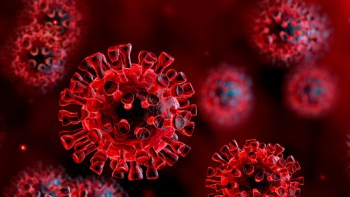
The fluid inside a cell’s nucleus is 300 times more viscous than honey, according to Alexandra Zidovska and colleagues at New York University in the US who have confirmed the results of previous measurements using a new non-invasive technique. The team monitored the tiny motions of structures inside cellular nuclei to learn more about the mechanics of the nucleus. Their research could lead to a better understanding of the changes that occur in the cells of people with conditions such as cancer and Alzheimer’s disease.
As well as containing DNA, cellular nuclei are home to strands of RNA molecules the carry information between the nucleus and protein manufacturing sites, enabling important processes inside the cell to run smoothly. To understand how this system works, biologists need to know the viscosity of the medium through which RNA strands travel.
Previous studies have measured this viscosity by injecting small beads into nuclei using needles and then manipulating their movements with magnetic fields. This technique is damaging to cells, which makes it unclear whether its results would be the same in healthy, undamaged cells.
Red and green markers
Zidovska’s team overcame this problem by observing the movements of nucleoli, which are ball-shaped structures of entangled RNA and protein molecules that occur naturally inside nuclei and behave like liquid droplets. To observe their motions accurately, the researchers genetically modified cells so that their nucleoli carried red fluorescent markers, while the rest of the nucleus carried a green marker. Under a microscope, the clear contrast between structures enabled them to observe tiny oscillations on the surfaces of nucleoli. They also saw the nucleoli collide and fuse, which is a process that had not been seen directly before.
By measuring the amplitudes of the surface oscillations, Zidovska and colleagues calculated the surface tension of the nucleoli. This yielded an extremely low value – around 50,000 times smaller than the surface tension of an airborne water droplet.
Slow process
The team also measured how the shape of two merging nucleoli changed over time, finding that they generally took around 15 min to fuse entirely. This, they note, is a slow process on cellular timescales. From principles of surface tension-driven coalescence, the team concluded that the medium surrounding the nucleoli an viscosity of around 3000 pascal-seconds. This is extremely high being around 30 million times more viscous that than water, and 300 times more viscous that than honey. The team’s results are in line with data gathered using more invasive techniques and knowing this reduces uncertainties in our understanding of the mechanics of fluid inside cellular nuclei.
Alzheimer’s disease and some cancers are associated with changes in the size and shape of nucleoli and therefore the new technique could have medical applications. “We think that further development of this approach can have potentially large implications for both disease diagnosis and therapy,” says Zidovska.
Zidovska and her colleagues are now studying the possible relationships between the mechanical properties of cell components and how genetic information is processed.
The study is described in Physical Review Letters.



